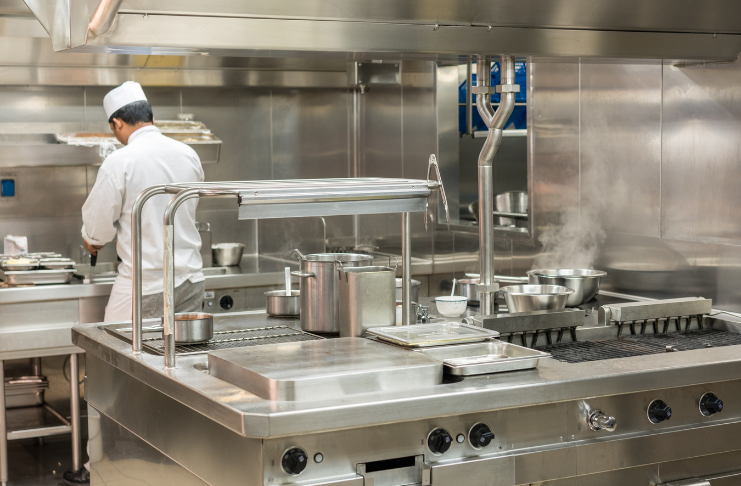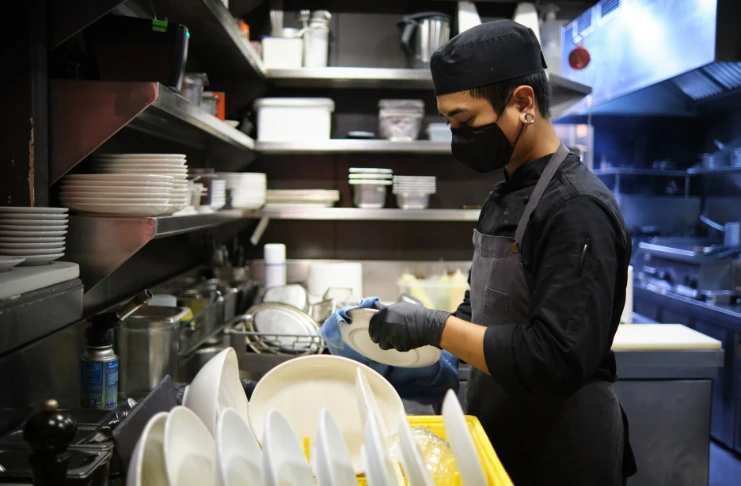
Designing a commercial kitchen is crucial for any restaurant’s overall operations, efficiency, and success. From food preparation to service, the kitchen is the heart of the restaurant. Investing time and effort in planning your restaurant kitchen layout improves workflow and enhances the overall dining experience.
Whether you are opening a new restaurant or renovating an existing one, understanding how to optimize ample kitchen space and functionality is essential. This guide will walk you through every step of designing a commercial kitchen, covering essential considerations, layout options, and key elements that will help you create a productive and safe kitchen space.
How to Design a Commercial Kitchen Layout for Your Restaurant
A commercial kitchen layout requires careful planning and strategic decision-making. Several factors influence the design, and addressing them early ensures long-term success.
1. Assessing the Type of Cuisine and Menu Being Served
The first step in designing a restaurant kitchen layout is determining the type of cuisine your restaurant will serve. A fast-food establishment, for example, requires a different setup than a fine-dining restaurant or a bakery. Your menu influences the type of equipment, prep stations, and cooking methods needed. For instance,
- A pizzeria would prioritize ovens, dough prep stations, and cooling racks.
- A sushi bar requires cold storage and specialized preparation areas for delicate handling.
2. Compliance with Health and Safety Regulations
A properly designed commercial kitchen must adhere to local health codes and safety regulations. This includes ventilation, fire safety, sanitation, and food storage guidelines. Ensuring your commercial kitchen equipment meets these requirements will prevent costly fines and operational disruptions. Some common regulations are:
- Placement of handwashing stations.
- Separation of raw and cooked food zones to prevent cross-contamination.
- Proper installation of ventilation systems.
3. Estimating Kitchen Capacity and Peak Operational Demands
Your kitchen should be designed to handle the peak hours efficiently, such as lunch and dinner rushes. Evaluate your seating capacity, expected customer turnout, and typical order patterns. For instance:
- A 50-seater café may need a smaller kitchen than a 200-seat fine-dining restaurant.
- During peak hours, the layout must offer seamless movement among chefs, prep cooks, and servers.
By anticipating these demands, you can optimize your restaurant kitchen layout for current and future growth.

4. Identifying Budget Constraints and Scalability for the Future
Budgeting is crucial when setting up a restaurant kitchen layout. While it’s tempting to go for the latest gadgets and expansive layouts, prioritizing essentials ensures you stay within your financial limits. Additionally, consider scalability. A flexible design for a commercial kitchen allows you to expand operations as your restaurant grows.
INDUSTRY INSIGHT
Sustainability is no longer optional—it’s essential for the future of the food service industry. Restaurants are integrating low-energy appliances, water-saving solutions, and recycling programs to reduce environmental impact and improve efficiency.
According to a source, in 2025, sustainable kitchen designs are expected to dominate the industry. This includes using recycled materials for surfaces and furnishings, as well as adopting water-saving and energy-efficient appliances. These practices not only reduce environmental impact but also align with consumer preferences for eco-friendly businesses.
Key Components of a Restaurant Kitchen Layout
An efficient restaurant kitchen layout consists of several key areas, each with a designated function to streamline workflow and maintain hygiene.
1. Cooking Area
When you design a commercial kitchen, ensure the following pointers:
- Equipment Placement: Stoves, ovens, grills, fryers, and steamers should be strategically positioned for easy access. Grouping similar equipment helps chefs work more efficiently.
- Ventilation: A high-quality ventilation system is critical for removing heat, smoke, and odors. Proper airflow ensures a comfortable working environment and prevents grease buildup.
- Safety Measures: Equip the cooking area with fire suppression systems and marked emergency exits. Non-slip flooring can further reduce the risk of accidents.
2. Prep Stations
Preparation stations should be strategically placed to minimize movement. Key considerations include:
- Zoning: Separate stations for cutting, mixing, marinating, and assembling ingredients can prevent cross-contamination. For example, designate one area for raw meat and another for vegetables.
- Tools and Surfaces: Stainless steel surfaces are durable, easy to clean, and comply with health regulations. Equip each station with appropriate tools, like knives, cutting boards, and mixing bowls.
- Proximity: Prep stations should be near storage areas and cooking zones to minimize unnecessary movement.
3. Storage Areas
Storage areas can be divided into three main categories:
- Dry Storage: Allocate space for non-perishable items such as grains, spices, and canned goods. Labeled shelves keep the area organized and facilitate inventory management.
- Cold Storage: Refrigeration and freezer units are essential for perishable items. Ensure that cold storage is spacious enough to handle peak inventory levels and is conveniently located near prep stations.
- Shelving Organization: Utilize vertical shelving to maximize space, and opt for adjustable shelves to accommodate items of different sizes. Clear labeling further enhances efficiency.
4. Dishwashing & Cleaning Area
A properly designed dishwashing area prevents the buildup of dirty dishes, ensuring smooth operations during peak hours. Important considerations include:
- Sinks and Dishwashers: Equip this area with multiple sinks—one for handwashing, one for dishwashing, and another for rinsing. A commercial dishwasher can speed up the cleaning process and save labor costs.
- Waste Disposal: Install garbage bins with lids and a waste management system for sorting recyclables. This will minimize clutter and reduce the risk of pests.
- Hygiene: To prevent bacteria buildup, use non-porous surfaces and anti-microbial flooring. Ensure the area has good lighting to maintain visibility during cleaning.
5. Service & Plating Area
The plating and service area should be close to the cooking stations to speed up the food preparation area delivery. Key features include:
- Warming Trays: Keep dishes warm and fresh before they are served to customers.
- Expedite Station: This area allows servers to pick up orders quickly. Utilize heat lamps to maintain food temperatures during service.
- Plating Surfaces: Allocate sufficient counter space for chefs to plate dishes with precision and consistency.
6. Delivery
With the rise of online food orders, incorporating a designated delivery area within your restaurant kitchen layout ensures a seamless process for packing and dispatching takeout orders. Key considerations include:
- Packing Stations: Designate a space for packaging meals with insulated containers, ensuring food stays hot or cold during transit.
- Storage for Delivery Supplies: Keep boxes, bags, and utensils organized and easily accessible.
- Pickup Accessibility: The delivery area should be located near an exterior entrance to minimize disruptions to in-house dining and kitchen operations.
Types of Commercial Kitchen Layouts: Which Design Works Best for You?
Choosing the right restaurant kitchen layout is crucial for optimizing efficiency, safety, and productivity. Here are six popular commercial kitchen layouts:
1. Assembly Line Layout
The layout organizes kitchen stations sequentially linearly, where each station performs a specific dish preparation task. Benefits of assembly line layout:
- Efficiency in High-Volume Service: Perfect for fast-food chains or buffet-style restaurants, this layout allows for rapid production and delivery, even during peak hours.
- Simplified Workflow: Staff members focus on individual tasks, reducing errors and improving consistency.
- Streamlined Operations: The linear arrangement minimizes staff movement, saving time and energy.
2. Island Layout
It features a central cooking hub surrounded by prep, cleaning, and storage areas. Chefs can work collaboratively around the central station. Benefits:
- Encourages Teamwork: The central cooking hub promotes interaction and collaboration among kitchen staff.
- Ideal for Open Kitchens: Often found in open-kitchen designs, this layout allows customers to watch their meals being prepared, enhancing the dining experience.
- Space Optimization: Suitable for spacious kitchens, the layout maximizes efficiency and accessibility.
3. Zone-Style Layout
This commercial kitchen layout divides the kitchen into specific areas dedicated to tasks such as food prep, cooking, plating, and cleaning. Benefits::
- Reduces Congestion: Staff can work simultaneously without crossing paths by assigning tasks to dedicated zones, minimizing chaos during busy periods.
- Customizable for Complex Menus: This is ideal for restaurants with diverse menus, as each zone can cater to a different cuisine or preparation style.
- Improves Organization: Clearly defined zones enhance workflow and accountability among staff.
4. Galley Layout
The galley layout consists of parallel counters or workstations with a narrow aisle. It’s commonly used in compact kitchens like food trucks or small restaurants. Benefits:
- Maximizes Space Efficiency: The parallel setup utilizes limited kitchen space effectively, making it ideal for small establishments.
- Streamlined Workflow: Staff can quickly move between counters without excessive walking or unnecessary detours.
- Cost-Effective: Requires fewer resources and less equipment compared to larger layouts.
5. Open Kitchen Layout
An open kitchen design allows customers to see their food being prepared. This layout works well for interactive dining experiences and creates transparency between the restaurant and its guests. Benefits:
- Customer Engagement: Creates a unique dining experience by offering transparency and interaction with chefs.
- Showcases Quality: Highlights the cleanliness and professionalism of your kitchen, building customer trust.
- Memorable Ambiance: Adds an element of theater to the dining experience, particularly in upscale or interactive dining venues.
6. Ergonomic Layout
An ergonomic restaurant kitchen layout prioritizes efficiency and reduces unnecessary movement. It ensures that equipment, storage, and prep areas are strategically placed to minimize fatigue and increase productivity. Benefits:
- Reduces Fatigue: Decreases unnecessary movement, allowing staff to work comfortably and efficiently.
- Boosts Productivity: Simplifies tasks by ensuring all necessary tools and ingredients are easily accessible.
- Enhances Safety: Organized workspaces reduce clutter and the risk of accidents.
Key Considerations for Your Restaurant Kitchen Layout
When you design a commercial kitchen, several essential factors should be considered to optimize performance and ensure smooth operations.
1. Energy Efficiency
An energy-efficient restaurant kitchen layout reduces operational costs, as commercial kitchens consume significant power through cooking equipment, refrigeration, and lighting. Restaurants incorporating energy-efficient appliances, such as Energy Star-rated ovens and refrigerators, can significantly reduce electricity bills. Optimizing kitchen ventilation also helps reduce cooling costs by maintaining airflow and temperature. A well-ventilated kitchen reduces excess heat and improves staff comfort, which, in turn, enhances productivity.
2. Space Efficiency
Maximizing space is crucial, especially for smaller kitchens. Using vertical shelving, wall-mounted racks, and multi-purpose equipment like combination ovens helps maximize space.
For example, a food truck or a small café may benefit from foldable prep tables and under-counter storage, ensuring the kitchen remains uncluttered and functional. By designing a compact yet well-organized space, chefs and kitchen staff can work efficiently without unnecessary movements.
3. Maintenance
A well-maintained kitchen requires careful planning to avoid costly repairs and downtime. Choosing durable, easy-to-clean materials like stainless steel for countertops and kitchen surfaces ensures hygiene while extending the longevity of the workspace. A proactive maintenance schedule for equipment, such as regular cleaning of grease traps and exhaust hoods, prevents malfunctions and health code violations.
For example, a restaurant that schedules deep cleaning and routine inspections avoids the sudden breakdown of critical appliances, which could otherwise lead to service delays and revenue loss of food business.

4. Supervision & Training
The kitchen should be structured in a way that allows managers and head chefs to oversee operations effortlessly. In a fast-paced environment, a clear line of sight between stations enables supervisors to monitor food preparation and ensure consistency in dish quality.
Additionally, a well-organized kitchen simplifies the training process for new hires. For instance, a quick-service restaurant with a structured assembly line layout allows employees to grasp their roles faster, reducing errors and improving service speed.
5. Flow
An efficient layout should allow food to move seamlessly from storage to prep stations, cooking areas, plating, and finally to service. Poorly planned layouts lead to bottlenecks, where staff may constantly bump into each other, slowing down operations.
In a high-volume pizzeria, for example, an assembly line setup ensures that the dough is prepared in one section, passed onto the topping station, then into the oven, and finally to the plating area in a smooth, uninterrupted process.
6. Simplicity
Overcomplicating the layout with excessive stations or unnecessary equipment can hinder productivity. A clutter-free kitchen allows staff to work more efficiently, reducing confusion and wasted motion. Restaurants with minimalist, well-organized workstations improve speed and reduce stress among kitchen staff.
For example, a sushi bar with a simple, streamlined workstation allows chefs to prepare rolls quickly without reaching for ingredients in multiple locations.
7. Air Ventilation
Proper airflow reduces heat buildup, removes smoke, and prevents lingering food odors. Installing high-quality exhaust systems and ensuring that ventilation hoods are placed strategically helps maintain air quality.
In large commercial kitchens, poor ventilation can lead to discomfort among staff, increasing the likelihood of fatigue and mistakes. For example, a steakhouse with multiple grills must have a powerful exhaust system to eliminate smoke and maintain a breathable atmosphere.

8. Sanitation & Safety
Your restaurant kitchen layout must comply with hygiene and safety regulations, ensuring that raw and cooked food areas are separate to prevent cross-contamination. Installing multiple hand-washing stations, using non-slip flooring, and keeping fire extinguishers accessible are essential safety measures.
A well-planned kitchen also includes clearly marked exits and emergency protocols. A well-designed dishwashing area, for instance, ensures that soiled dishes are cleaned efficiently without interfering with food preparation zones, maintaining high hygiene standards.
9. Flexibility & Modularity
A flexible kitchen design design allow for future adjustments as business needs change. Modular equipment that can be rearranged easily provides the flexibility to introduce new menu items or expand kitchen operations. A growing restaurant may start with a basic setup but later introduce new cooking stations as demand increases.
For example, a small bakery that initially operates with a single oven may later invest in additional equipment as its business scales, making a modular design advantageous.
10. Technology
Integrating technology enhances efficiency in modern restaurant kitchens. Digital kitchen display systems (KDS) streamline order management by replacing handwritten tickets, reducing communication errors between front-of-house and kitchen staff. Smart appliances with temperature monitoring and automated timers ensure food consistency and minimize waste.
For instance, a high-tech burger chain using an automated grilling system can cook patties to perfection without constant human intervention, speeding up service while maintaining quality.
Conclusion
Designing a commercial kitchen requires careful planning to ensure efficiency, safety, and productivity. By choosing the right restaurant kitchen layout and optimizing workflow, you can create a well-organized space that meets your restaurant’s needs. Consider factors like energy efficiency, hygiene, and scalability to future-proof your commerical kitchen design and ensure long-term success.
A well-thought-out restaurant kitchen layout enhances service speed, reduces operational costs, and ensures a seamless culinary experience for both staff and customers. Whether you’re setting up a new restaurant or revamping an existing one, following these guidelines will help you design a commercial kitchen that is both functional and profitable.
Frequently Asked Questions
- Identifying the type of cuisine and menu to determine equipment needs.
- Dividing the kitchen into prep, cooking, storage, dishwashing, service area.
- Ensuring compliance with local health and safety regulations.
- Considering peak operational demands and staff flow to avoid bottlenecks.
- Prioritizing energy efficiency and scalability for future expansion.
A general rule of thumb is to allocate 30-40% of the total square footage of restaurant space to the kitchen. For example, if your restaurant is 2,000 square feet, the kitchen should occupy approximately 600-800 square feet. However, this varies based on the type of restaurant and operational needs.
- Preparation Area: For cutting, mixing, and assembling ingredients.
- Cooking Area: Houses stoves, ovens, grills, and fryers.
- Storage Area: Includes dry storage, cold storage, and shelving.
- Dishwashing Area: For cleaning dishes and utensils.
- Well-organized with a logical workflow.
- Equipped with durable and energy-efficient appliances.
- Hygienic, with proper ventilation and sanitation facilities.
- Designed to minimize staff movement and reduce preparation time.
- Use stainless steel for countertops and shelving for a professional look.
- Install open shelving for accessible storage.
- Incorporate proper lighting to highlight work areas and add ambiance.
- Add high-quality cookware and appliances similar to those in commercial kitchens.
- Maintain a clutter-free and organized space to mimic professional setups.
- Workflow efficiency to reduce unnecessary movement.
- Compliance with health and safety standards.
- Adequate ventilation for comfort and safety.
- Sufficient storage and prep space to handle peak demands.
- Energy efficiency and easy maintenance for cost savings.
The golden rule for kitchen design is the “kitchen work triangle.” This principle ensures that the stove, refrigerator, and sink are positioned at three points of a triangle, making them easily accessible while using limited space and minimizing movement.
The best layout depends on your restaurant’s size and concept:
- Assembly Line Layout: Ideal for high-volume kitchens like fast-food chains.
- Zone-style Layout: Best for restaurants with diverse menus.
- Island Layout: Perfect for large spaces and collaborative environments.
- Galley Layout: Suited for small, narrow kitchens.
- Open Kitchen Layout: Great for customer-facing operations.
- The type of cuisine and menu.
- Efficient flow of staff and food preparation.
- Compliance with health codes and safety standards.
- Scalability for future growth.
- Placement of equipment to optimize space usage.
- Determine the total restaurant area.
- Allocate 30-40% of this space to the kitchen.
- Adjust based on the type of restaurant (e.g., fast food requires more kitchen space than fine dining).
- Factor in storage, preparation zones, cooking stations, and washing areas to finalize the layout.









